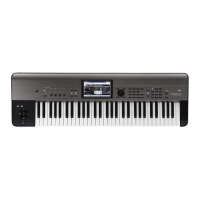Sequencer: Menu Command Piano Roll
175
Entering data
1. Press the tool.
2. Choose the data that will be shown in the control view
area.
3. Drag over the region in which you want to enter data.
The path on which you drag is shown by a line. When
you release, values will be entered to fit that line.
Erasing data
1. Press the tool.
2. Choose that data that will be shown in the control view
area.
3. Press on the data that you want to erase, or drag across
the region that you want to erase. When you release, the
data will be erased.
Event list
Use Meas (Measure) and # (Index) to display the measure
that you want to edit and the desired index number within
that measure.
If you change # to choose control data such as AFTT or
CC#01 in the lower area, the control view select value will
also change, and those values will be shown in the control
view area.
When you select an event in the note/control view area, the
event will turn light blue and that value will be shown in the
event list. If you use “#” to select a different event, the
selected event will be shown in dark blue, and the light blue
event will turn red.
Select the event that you want to edit, and use the VALUE
controllers to enter the desired values.
• By editing the BT (Beat Tick) location within the measure,
you can move an event within that measure.
• You can edit each type of event data. When you select a
note event, it will sound.
The following table shows the types of data and the
available values that you can edit in “Piano Roll: Event
Edit.”
* Note data and velocity values can also be entered by
holding down the ENTER button and playing a note on the
keyboard.
Undo, Redo button
You can press the Undo button to cancel the most recent
edit. The Redo button returns to the edited state. These
buttons allow you to return only to the state prior to the
single most recent operation.
Setup button
Press the Setup button to access the Piano Roll Setup dialog
box, where you can make settings such as the resolution
when editing in the note view area.
Piano Roll Setup dialog box
Move Note Resolution [Free,
, , , , ]
When you drag a note event horizontally, it will move in
units of the resolution you specify here. For example if you
set this to , dragging an event at location BT:1.001 toward
the right will successively move it to locations 2.01, 3.001,
4.001, etc. This adjustment will not occur if you choose the
Free setting.
This setting is valid if Snap to Grid is Off.
Snap to Grid [Off, On]
On: When you drag a note event horizontally, it will snap to
the resolution specified by Grid Resolution. For example if
Grid Resolution is set to , dragging an event at location
BT:1.001 toward the right will move it to locations 2.000,
3.000, 4.001, etc. The locations to which you can move a note
will be limited to precise quarter‐note intervals.
A dotted grid is displayed in the note/control view area
according to the Grid Resolution setting.
Off: Notes will not snap to the grid. They will move at the
resolution specified by Move Note Resolution.
BAR (displayed only)
(Measure line)
Meter: 1/4...16/16
(Time signature)
C–1...G9 *
(Note data)
V: 1...127 *
(Velocity)
L: 000.000...15984.000
(Length: beats, clocks)
PAFT
(Polyphonic after
touch)
C–1...G9
(Note number)
0...127
(Value)
CTRL
(Control change)
C: 0...119
(Control change
number)
0...127
(Value)
AFTT
(After Touch)
0...127
(value)
BEND
(Pitch bend)
–8192...+8191
(value)

